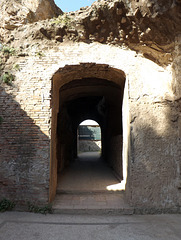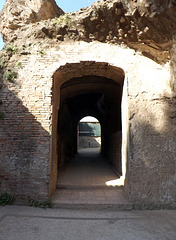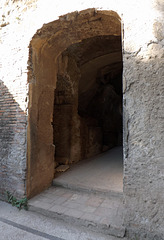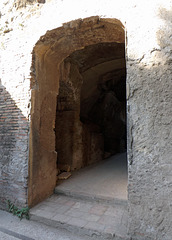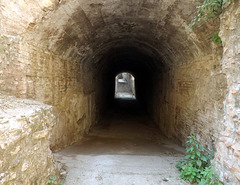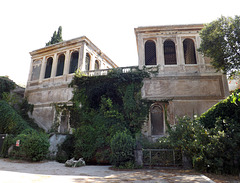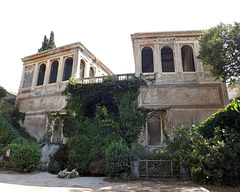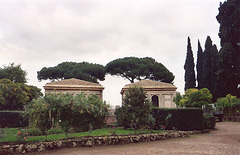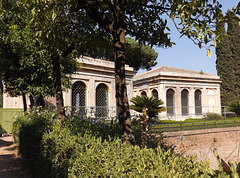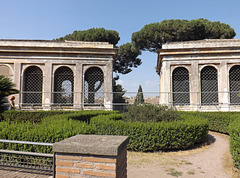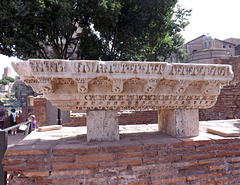
Forum Romanum & Palatine Hill
Folder: Italy
The Entrance to the Cryptoporticus of Nero on the…
| |
|
The Entrance to the Cryptoporticus of Nero on the…
| |
|
The Entrance to the Cryptoporticus of Nero on the…
| |
|
The Entrance to the Cryptoporticus of Nero on the…
| |
|
The Cryptoporticus of Nero on the Palatine Hill, J…
| |
|
The Cryptoporticus of Nero on the Palatine Hill, J…
| |
|
Stuccoed Vault inside the Cryptoporticus of Nero o…
| |
|
Stuccoed Vault inside the Cryptoporticus of Nero o…
| |
|
The Farnese Gardens on the Palatine Hill in Rome,…
| |
|
The Farnese Gardens (Orti Farnesiani sul Palatino or "Gardens of Farnese upon the Palatine") are a garden in Rome, central Italy, created in 1550 on the northern portion of Palatine Hill, by Cardinal Alessandro Farnese. They were the first private botanical gardens in Europe (the first botanical gardens of any kind in Europe being started by Italian universities in the mid-16th century, only a short time before).
Alessandro Farnese was appointed Cardinal Deacon of the Roman Catholic Church in 1534 at the age of 14, by Paul III, his grandfather, who had been elected to the papacy two months previously. He is remembered for being an antiquarian who assembled the greatest collection of Roman sculpture assembled in private hands since antiquity. In 1550, when Farnese acquired a northern portion of Palatine hill (historically the oldest of Rome's seven hills) he had ruins from a Roman palace of Tiberius at the northwest end of the hill top filled in, and converted to a summer home. The site overlooks the Roman Forum and is near the Arch of Titus. He called this Horti Farnesiani (possibly meaning to suggest the hortus conclusus or "enclosed garden" where Mary conceived Jesus Christ). The garden was divided into the classic style of quadrants with a well or a fountain at its centre, deriving from the design of the Roman peristilium palaces of the area, as re-created by the noted architect Vignola.
Though little of the Farnese Gardens survives today, some remnant structures may be seen.
Text from: en.wikipedia.org/wiki/Farnese_Gardens
The Farnese Gardens on the Palatine Hill in Rome,…
| |
|
The Farnese Gardens (Orti Farnesiani sul Palatino or "Gardens of Farnese upon the Palatine") are a garden in Rome, central Italy, created in 1550 on the northern portion of Palatine Hill, by Cardinal Alessandro Farnese. They were the first private botanical gardens in Europe (the first botanical gardens of any kind in Europe being started by Italian universities in the mid-16th century, only a short time before).
Alessandro Farnese was appointed Cardinal Deacon of the Roman Catholic Church in 1534 at the age of 14, by Paul III, his grandfather, who had been elected to the papacy two months previously. He is remembered for being an antiquarian who assembled the greatest collection of Roman sculpture assembled in private hands since antiquity. In 1550, when Farnese acquired a northern portion of Palatine hill (historically the oldest of Rome's seven hills) he had ruins from a Roman palace of Tiberius at the northwest end of the hill top filled in, and converted to a summer home. The site overlooks the Roman Forum and is near the Arch of Titus. He called this Horti Farnesiani (possibly meaning to suggest the hortus conclusus or "enclosed garden" where Mary conceived Jesus Christ). The garden was divided into the classic style of quadrants with a well or a fountain at its centre, deriving from the design of the Roman peristilium palaces of the area, as re-created by the noted architect Vignola.
Though little of the Farnese Gardens survives today, some remnant structures may be seen.
Text from: en.wikipedia.org/wiki/Farnese_Gardens
The Farnese Gardens on the Palatine Hill in Rome,…
| |
|
The Farnese Gardens (Orti Farnesiani sul Palatino or "Gardens of Farnese upon the Palatine") are a garden in Rome, central Italy, created in 1550 on the northern portion of Palatine Hill, by Cardinal Alessandro Farnese. They were the first private botanical gardens in Europe (the first botanical gardens of any kind in Europe being started by Italian universities in the mid-16th century, only a short time before).
Alessandro Farnese was appointed Cardinal Deacon of the Roman Catholic Church in 1534 at the age of 14, by Paul III, his grandfather, who had been elected to the papacy two months previously. He is remembered for being an antiquarian who assembled the greatest collection of Roman sculpture assembled in private hands since antiquity. In 1550, when Farnese acquired a northern portion of Palatine hill (historically the oldest of Rome's seven hills) he had ruins from a Roman palace of Tiberius at the northwest end of the hill top filled in, and converted to a summer home. The site overlooks the Roman Forum and is near the Arch of Titus. He called this Horti Farnesiani (possibly meaning to suggest the hortus conclusus or "enclosed garden" where Mary conceived Jesus Christ). The garden was divided into the classic style of quadrants with a well or a fountain at its centre, deriving from the design of the Roman peristilium palaces of the area, as re-created by the noted architect Vignola.
Though little of the Farnese Gardens survives today, some remnant structures may be seen.
Text from: en.wikipedia.org/wiki/Farnese_Gardens
The Farnese Gardens on the Palatine Hill in Rome,…
| |
|
The Farnese Gardens (Orti Farnesiani sul Palatino or "Gardens of Farnese upon the Palatine") are a garden in Rome, central Italy, created in 1550 on the northern portion of Palatine Hill, by Cardinal Alessandro Farnese. They were the first private botanical gardens in Europe (the first botanical gardens of any kind in Europe being started by Italian universities in the mid-16th century, only a short time before).
Alessandro Farnese was appointed Cardinal Deacon of the Roman Catholic Church in 1534 at the age of 14, by Paul III, his grandfather, who had been elected to the papacy two months previously. He is remembered for being an antiquarian who assembled the greatest collection of Roman sculpture assembled in private hands since antiquity. In 1550, when Farnese acquired a northern portion of Palatine hill (historically the oldest of Rome's seven hills) he had ruins from a Roman palace of Tiberius at the northwest end of the hill top filled in, and converted to a summer home. The site overlooks the Roman Forum and is near the Arch of Titus. He called this Horti Farnesiani (possibly meaning to suggest the hortus conclusus or "enclosed garden" where Mary conceived Jesus Christ). The garden was divided into the classic style of quadrants with a well or a fountain at its centre, deriving from the design of the Roman peristilium palaces of the area, as re-created by the noted architect Vignola.
Though little of the Farnese Gardens survives today, some remnant structures may be seen.
Text from: en.wikipedia.org/wiki/Farnese_Gardens
The Farnese Gardens on the Palatine Hill in Rome,…
| |
|
The Farnese Gardens (Orti Farnesiani sul Palatino or "Gardens of Farnese upon the Palatine") are a garden in Rome, central Italy, created in 1550 on the northern portion of Palatine Hill, by Cardinal Alessandro Farnese. They were the first private botanical gardens in Europe (the first botanical gardens of any kind in Europe being started by Italian universities in the mid-16th century, only a short time before).
Alessandro Farnese was appointed Cardinal Deacon of the Roman Catholic Church in 1534 at the age of 14, by Paul III, his grandfather, who had been elected to the papacy two months previously. He is remembered for being an antiquarian who assembled the greatest collection of Roman sculpture assembled in private hands since antiquity. In 1550, when Farnese acquired a northern portion of Palatine hill (historically the oldest of Rome's seven hills) he had ruins from a Roman palace of Tiberius at the northwest end of the hill top filled in, and converted to a summer home. The site overlooks the Roman Forum and is near the Arch of Titus. He called this Horti Farnesiani (possibly meaning to suggest the hortus conclusus or "enclosed garden" where Mary conceived Jesus Christ). The garden was divided into the classic style of quadrants with a well or a fountain at its centre, deriving from the design of the Roman peristilium palaces of the area, as re-created by the noted architect Vignola.
Though little of the Farnese Gardens survives today, some remnant structures may be seen.
Text from: en.wikipedia.org/wiki/Farnese_Gardens
The Farnese Gardens on the Palatine Hill in Rome,…
| |
|
The Farnese Gardens (Orti Farnesiani sul Palatino or "Gardens of Farnese upon the Palatine") are a garden in Rome, central Italy, created in 1550 on the northern portion of Palatine Hill, by Cardinal Alessandro Farnese. They were the first private botanical gardens in Europe (the first botanical gardens of any kind in Europe being started by Italian universities in the mid-16th century, only a short time before).
Alessandro Farnese was appointed Cardinal Deacon of the Roman Catholic Church in 1534 at the age of 14, by Paul III, his grandfather, who had been elected to the papacy two months previously. He is remembered for being an antiquarian who assembled the greatest collection of Roman sculpture assembled in private hands since antiquity. In 1550, when Farnese acquired a northern portion of Palatine hill (historically the oldest of Rome's seven hills) he had ruins from a Roman palace of Tiberius at the northwest end of the hill top filled in, and converted to a summer home. The site overlooks the Roman Forum and is near the Arch of Titus. He called this Horti Farnesiani (possibly meaning to suggest the hortus conclusus or "enclosed garden" where Mary conceived Jesus Christ). The garden was divided into the classic style of quadrants with a well or a fountain at its centre, deriving from the design of the Roman peristilium palaces of the area, as re-created by the noted architect Vignola.
Though little of the Farnese Gardens survives today, some remnant structures may be seen.
Text from: en.wikipedia.org/wiki/Farnese_Gardens
The Farnese Gardens on the Palatine Hill in Rome,…
| |
|
The Farnese Gardens (Orti Farnesiani sul Palatino or "Gardens of Farnese upon the Palatine") are a garden in Rome, central Italy, created in 1550 on the northern portion of Palatine Hill, by Cardinal Alessandro Farnese. They were the first private botanical gardens in Europe (the first botanical gardens of any kind in Europe being started by Italian universities in the mid-16th century, only a short time before).
Alessandro Farnese was appointed Cardinal Deacon of the Roman Catholic Church in 1534 at the age of 14, by Paul III, his grandfather, who had been elected to the papacy two months previously. He is remembered for being an antiquarian who assembled the greatest collection of Roman sculpture assembled in private hands since antiquity. In 1550, when Farnese acquired a northern portion of Palatine hill (historically the oldest of Rome's seven hills) he had ruins from a Roman palace of Tiberius at the northwest end of the hill top filled in, and converted to a summer home. The site overlooks the Roman Forum and is near the Arch of Titus. He called this Horti Farnesiani (possibly meaning to suggest the hortus conclusus or "enclosed garden" where Mary conceived Jesus Christ). The garden was divided into the classic style of quadrants with a well or a fountain at its centre, deriving from the design of the Roman peristilium palaces of the area, as re-created by the noted architect Vignola.
Though little of the Farnese Gardens survives today, some remnant structures may be seen.
Text from: en.wikipedia.org/wiki/Farnese_Gardens
Sphinx in the Farnese Gardens on the Palatine Hill…
| |
|
The Farnese Gardens (Orti Farnesiani sul Palatino or "Gardens of Farnese upon the Palatine") are a garden in Rome, central Italy, created in 1550 on the northern portion of Palatine Hill, by Cardinal Alessandro Farnese. They were the first private botanical gardens in Europe (the first botanical gardens of any kind in Europe being started by Italian universities in the mid-16th century, only a short time before).
Alessandro Farnese was appointed Cardinal Deacon of the Roman Catholic Church in 1534 at the age of 14, by Paul III, his grandfather, who had been elected to the papacy two months previously. He is remembered for being an antiquarian who assembled the greatest collection of Roman sculpture assembled in private hands since antiquity. In 1550, when Farnese acquired a northern portion of Palatine hill (historically the oldest of Rome's seven hills) he had ruins from a Roman palace of Tiberius at the northwest end of the hill top filled in, and converted to a summer home. The site overlooks the Roman Forum and is near the Arch of Titus. He called this Horti Farnesiani (possibly meaning to suggest the hortus conclusus or "enclosed garden" where Mary conceived Jesus Christ). The garden was divided into the classic style of quadrants with a well or a fountain at its centre, deriving from the design of the Roman peristilium palaces of the area, as re-created by the noted architect Vignola.
Though little of the Farnese Gardens survives today, some remnant structures may be seen.
Text from: en.wikipedia.org/wiki/Farnese_Gardens
View of the Palatine Hill from the Forum in Rome,…
| |
|
The Palatine Hill (Latin: Palatium) is the centermost of the seven hills of Rome and is one of the most ancient parts of the city of Rome in Italy. It is some 70 metres high and looks down on one side upon the Forum Romanum and on the other side upon the Circus Maximus.
According to Roman mythology, the Palatine hill was where Romulus and Remus were found by the she-wolf that kept them alive. According to this legend, the shepherd Faustulus found the infants, and with his wife Acca Larentia raised the children. When they were older this is where Romulus decided to build Rome.
Rome has its origins on the Palatine. Indeed, recent excavations show that people have lived there since approximately 1000 BC.
Many affluent Romans of the Republican time (510 BC – c. 44 BC) had their residences there. The ruins of the palaces of Augustus (63 BC – 14), Tiberius (42 BC – 37) and Domitian (51 – 96) can still be seen.
The Palatine Hill was also the site of the festival of the Lupercalia.
One building, believed to be the residence of Livia (58 BC – 29), the wife of Augustus, is currently undergoing renovation. Situated near to the house of Livia is the palace of Cybele, currently not fully excavated and not open to the public. Behind this structure, cut into the side of the hill, is the so-called House of Tiberius.
Overlooking the Forum Romanum is the Flavian Palace which was built largely during the reign of the Flavian dynasty (69 – 96) – Vespasian, Titus and Domitian. This palace, which was extended and modified by several emperors, extends across the Palatine Hill and looks out over the Circus Maximus. The building of the greater part the palace visible from the Circus was undertaken in the reign of the Emperor Septimius Severus (146 – 211).
Immediately adjacent to the palace of Severus is the stadium of Domitian. This is a structure which has the appearance of a Roman Circus, but is of insufficient size to accommodate chariots. Its exact purpose is disputed. It may have been a venue for foot-racing, field sports or equestrian events.
The Palatine Hill is now a large open-air museum and can be visited during the daytime for a small charge. The entrance is near the Arch of Titus on the Forum Romanum.
During Augustus' reign, an area of the Palatine Hill was roped off for a sort of archaeological expedition, which found fragments of Bronze Age pots and tools. He declared this site the "original town of Rome". Modern archaeology has identified evidence of Bronze Age settlement in the area which predates Rome's founding. There is a museum on the Palatine in which artifacts dating from before the official foundation of the City are displayed. The museum also contains Roman statuary.
An altar to an unknown deity, once thought to be Aius Locutius, was discovered here in 1820.
In July of 2006 archaeologists announced the discovery of what they believe to be the birth place of Augustus.
According to Livy (59 BC – 17) the Palatine hill got its name from the Arcadian settlement of Pallantium. The term palace itself stems from Palatium.
Text from: en.wikipedia.org/wiki/Palatine_Hill
Marble Cornice from the House of the Vestal Virgin…
| |
|
Atrium Vestae: the house of the Vestal Virgins at the foot of the Palatine, just east of the forum proper. By the end of the republic this term had come to mean their dwelling-house, in which sense it is ordinarily used in extant literature (Fest. 333; Gell. I.12.9; Plin. Ep. VII.19.2; Prud. Peristeph. II.528), but originally it included the whole precinct of Vesta (cf. Ov. Fast. VI.263; Serv. Aen. VII.153). This precinct contained the temple of Vesta (q.v.), the dwelling of the Vestals, the sacred grove, and the Regia (q.v.) or house of the king. This group was called both Regia and atrium Vestae (Ov. Fast. VI.263‑264: hic locus exiguus qui sustinet atria Vestae | tunc erat intonsi regia magna Numae; cf. the confused terms atrium regium (Liv. XXVI.27.3; XXVII.11.16, in reference to the fire of 210 B.C.) and regia Vestae (CIL VI.511).
The grove, lucus (Cic. de div. I.101; BC 1905, 208‑210; Mél. 1908, 238‑240), originally covered the space between the atrium and the Palatine, but was gradually encroached upon, and finally disappeared entirely, as it would seem. There is not sufficient evidence for associating CIL VI.30960, 30976, with this shrine (Jord. I.2.298). The domus Publica (Suet. Caes. 46) still continued to be the residence of the pontifex maximus until Augustus, on assuming that office in 12 B.C., transferred it to the Palatine (Cass. Dio LIV.27) and presented the domus Publica to the Vestals (Jahrb. d. Inst. 1889, 247). In 36 B.C. Domitius Calvinus built the marble Regia, an entirely separate structure. After the republic, therefore, the precinct of Vesta included the temple, the grove, and the actual dwelling of the Vestals, to which the name atrium was generally restricted. This name would lead us to infer that the court, atrium, was the most prominent part of the precinct, and it was certainly large enough for meetings of the senate ( Serv. Aen. VII.153: ad atrium Vestae conveniebat (senatus) quod a templo remotum fuerat — a disputed passage, cf. Van Deman, Atrium Vestae 10).
Knowledge of the history of the atrium must be derived from the evidence of the ruins themselves. Some discoveries were made in 1549 (Lanciani, Storia II.203), and extensive excavations were carried out in 1883 and 1899‑1902 (for the results in 1883 see Lanciani, NS 1883, 468‑470, 480‑486; Ruins 228‑234; Jordan, Der Tempel der Vesta u. d. Haus der Vestalinnen, 1886, 25‑40; Top. I.2.292, 427; Auer, Der Tempel der Vesta u. d. Haus der Vestalinnen, Denkschr. d. Wiener Akademie, 1886, 209‑222; Middleton, Ancient Rome I.307‑329; Gilbert I.304‑305; III.408‑410; for those of 1899‑1902, NS 1899, 325‑333; 1900, 159‑191; BC 1899, 253‑256; 1902, 30; 1903, 70‑78; AA 1900, 8‑9; CR 1899, 467; 1900, 238; 1901, 139; 1902, 284; Mitt. 1902, 90‑92; 1905, 94; Atti 539‑547; HC 204‑217; Thédenat 316‑334; RE I. A. 502‑504; DR 275‑293. All previous work has been superseded by Dr. Esther B. Van Deman's The Atrium Vestae, Washington, the Carnegie Institution, 1909). Cf. also ASA 154, 155; HFP 46‑48.
These excavations show some remains of the republican atrium, that is, the house of the Vestals, immediately south of the temple, adjoining the domus Publica on the east, with the same north and south orientation. This indicates the antiquity of both, though almost no remains earlier than the second century B.C. are now visible. They consist of a small court with rows of rooms on the south and west sides, with walls and pavements still visible at some points under the north-west corner of the Sullan period (JRS 1922, 29). The domus Publica seems to have been larger than the house of the Vestals, and to have occupied all the space between the Sacra via and the earlier Nova via. Its remains, forming virtually a part of the original atrium (there is, in any case, no line of demarcation between the two), lie along the north side of the latest building and were entirely covered up by the road that Nero built here in front of the shops (see below) (TF 85‑86; (Ill. 7)).
Close to the main entrance to the atrium, at its north-west corner, is the podium, about 3 by 2
Jump to top
RSS feed- Latest items - Subscribe to the latest items added to this album
- ipernity © 2007-2024
- Help & Contact
|
Club news
|
About ipernity
|
History |
ipernity Club & Prices |
Guide of good conduct
Donate | Group guidelines | Privacy policy | Terms of use | Statutes | In memoria -
Facebook
Twitter

